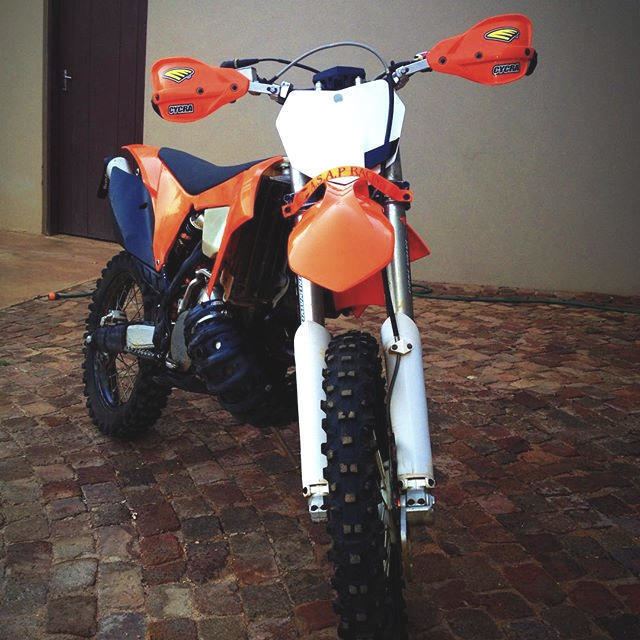Predecessor KTM 300 GS Bore / stroke 72 mm / 72 mm, 293 cc | ||
 | ||
Also called KTM 300 XC, KTM 300 XC-W Engine | ||
The KTM 300 is a series of 2-stroke enduro off-road motorcycles made by KTM. They are the Penton-inspired 1984 300 GS, the 300 DMX, the dirt only 300 MXC, European road legal 300 EXC and their current US counterparts the 300 XC (close-ratio) and 300 XC-W (wide-ratio gear box) respectively. The KTM 300 is designed for difficult off-road conditions. The 300 EXC and the 300 XC-W have a small headlight, speedometer, tail-light and somewhat softer linkless PDS suspension. Starting in 2008 all 300's came with electric start.
Contents
1984–1989
The original 300GS Enduro grew out of the experience with 250 cc Penton Hare Scrambler and other KTM air cooled 2-stroke enduro bikes. Since the 1986 rules for the International Six Days Enduro (ISDE) for the open class allowed any bike larger that 250 cc, KTM started work on a water cooled over-250 cc bike for the open class. They essentially bored their 250 out to 273 cc and called it a 300. This version of the 300 was discontinued in 1987. KTM also tried sleeving down their 500 cc two-stroke to 350 cc calling it the 350GS, but the left side kick-starter and the right side chain were not popular.
1990–1997
In 1990 KTM got serious and the present-day 300 was born. Dubbed the 300 EX/C it's engine delivered very smooth power and did not produce a power hit. At low RPMs the bike could go almost anywhere. In the mid-range and the top-end the smooth power delivery allowed the rider control over a wide variety riding conditiond from tight trails to wide open stretches. The plush suspension worked well compared to the older GS models.
The bike was also offered as the 300 DMX, a California desert version. These early KTM motors had 297 cc displacement with 72 mm x 73 mm bore/stroke. Still the 300 hadn't reached its full potential. Ignition and jetting problems plagued these early models. In 1992 the company suffered financial woes and development was slowed. The 1993 KTMs had Öhlins USD forks. In 1993 Motoplat went out of business, forcing KTM to switch to SEM ignition systems. The 1996 model had Marzocchi USD forks and an Öhlins rear shock absorber, a chrome exhaust pipe and silencer, a motor with better performance, increased cooling and stock Boysen reeds. For 1996–97 the bike was offered in a 360 cc version. In 1997 KTM switched to Kokusan ignition systems.
1998–2003
1998 was the first year for the KTM trademark orange bikes. In addition to larger capacity radiators, the 300 received KTM’s PDS link-less rear suspension with 320 mm of rear wheel travel. The bike was again offered in a bored out 380 cc 1998 model year version. In 1999 the 300 received a hydraulic clutch and the 2000 motor benefited from a redesigned cylinder.
2004–2007
In 2004 there was another frame change. There were significant engine changes, including a bore and stroke change and the carburetor size reduced from 38 mm to 36 mm, resulting in an 8 lb (3.6 kg) weight savings and no more jetting problems. For 2006, the US version of the 300 EXC was replaced by XC and XC-W. Both versions had 5-speed gearboxes and a stator for producing electricity. The 300 XC had a close-ratio gear box, no wiring for lights, and a stiffer suspension. The 300 XC-W had a wide-ratio gear box, head light, tail light and maintained the softer PDS suspension. The 2007 model had added a dual ignition mapping switch on the handlebar.
2008–2016
The 2008 KTM 300 EXC is the first electric start two-stroke enduro bike to be released by a major manufacturer. For 2010, Husaberg the other KTM owned bike company, offered the TE300, an XC-W with minor modifications to the body and suspension settings. From 2011 on the 300s got 6-speed gearboxes, a new exhaust pipe and silencer, and translucent fuel tanks. The 2012s got improvements to the starter, more frame changes resulting in more wheel travel, and a new air box with a filter that can be replaced without the use of tools. The 2013s got a diaphragm spring clutch, a stronger starter and lighter battery. In 2013, the Husaberg became the Husqvarna TE300 and was given the linkage rear suspension. The 2014 had a new CDI ignition system. The 2015 model chromoly steel frame is painted orange like the motocross models. All the 2015 models have the new WP 4CS forks with revised damping, the ability to make adjustments on the fly and a smaller front axle. The triple clamps have 2 mm less offset resulting in more trail and different steering characteristics. The rear shock is longer but the travel is unchanged. The electric starter has different gearing to provide higher initial torque from the electric motor, and the battery is lighter and stronger.
2017– Present
The 2017 KTM 300 EXC is a completely redesigned bike. A counter-balancer was added to reduce motor vibration. The case is a new design featuring a new position for the starter motor. A Mikuni carb replaced the Keihin carburetor.
